So you want to plant a survival garden for you and your family, but you’re not sure what the best victory garden size should be. This is the biggest decision new gardeners will have to make after first determining where to plant their garden. The two decisions are often interconnected.
The phrase “war garden” and “victory garden” grew out of World War I and World War II domestic efforts to increase food production to help war efforts. For preppers, victory gardens represent a coordinated effort to create greater self-reliance.
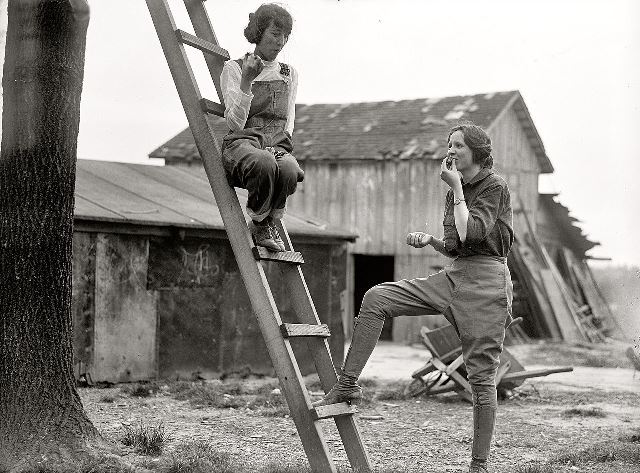
To determine the best victory garden size for you, I have pulled (and adapted) text from the original ABC of Victory Gardens guide. This was published during World War II by the Department of Agriculture. This guide advised its readers to “Make your plans carefully and grow a victory garden even if it is a small one.” Because location and size go hand-in-hands, you must also determine…
Where to Locate Your Victory Garden
The ideal location, is of course, right in your own back yard, if that is possible. Next best is that empty lot next door, if you are fortunate enough to have one there. Ask the owner for permission to use it. Regardless, don’t go too far away from your home. Remember that you will have to carry your tools and other material each time you want to work. The fact that your garden will require watering is another reason to locate it as near your home as possible. A handy water faucet to which you can attach a hose is much preferred to running back and forth with a watering can. If the summer is dry the availability of a hose will be absolutely necessary.
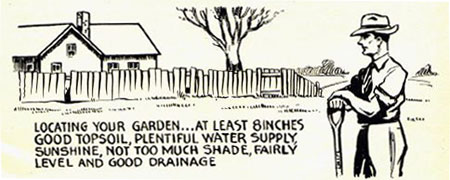
Requirements for a Good Victory Garden
Plenty of Good Sunshine
It’s the sun that makes vegetables grow, so be sure that your garden is well away from trees. They will not only keep the sun away, but their roots will steal moisture and nourishment from the ground. A simple rule to follow is to keep your garden as many feet away from a tree as the tree is high. For example, if the nearest tree is twenty feet high, keep the edge of your garden at least twenty feet away from its trunk. The same rule applies to any nearby shrubs or bushes.
Good, Deep Topsoil
Good topsoil is just as important as sunshine. You cannot grow crops where the soil has been removed or where it is only a few inches deep. A depth of at least 8 inches is desirable. It should be quite free of rocks and stones or you will find it very difficult to work. It should be comparatively level or the soil is apt to wash away. A lawn that has been turned over makes one of the best soils. Whatever the nature of your topsoil may be, it can be greatly improved by your own efforts.
Drainage Necessary
Most level or slightly sloping plots of ground will have good drainage. Low lying ground that remains wet for any considerable length of time after a rainstorm is not satisfactory. Ground that is always swampy and wet is, of course, no place for a vegetable garden.
How Big Should Your Victory Garden Be?
There are factors to be considered before you decide how big your garden should be.
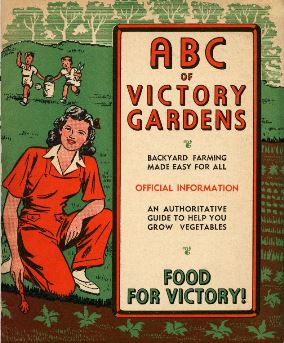
FIRST – How big is the available space? You may not want to use all of it, but you may also have to be satisfied with a smaller space than you would like. You can have your garden in two sections if that is the only way to get sufficient space for your plans. The closer these sections are together the easier they will be to attend.
SECOND – How experienced are you at gardening? While there is nothing mysterious or difficult about growing vegetables, a beginner will not be able to work as fast as an experienced gardener. You may find later that you are unwilling or unable to do the necessary amount of work to bring the crops through to their ripening stage. Remember, too, that a modest garden will supply you with a surprising quantity of vegetables. Of course, if too much ripens at once (and you don’t can it) you can always share it with your neighbors (but it does mean extra work).
Related: How to Build a Concrete Block Raised Bed Garden
Review the plans of various size gardens that follow and select one that you can successfully handle. If you are experienced, you need little guidance. Undoubtedly you will plan one big enough to meet your current needs as well as supply you with a surplus for canning or storage. We also advise the beginner to stick to the easy-to-grow annuals and leave the perennials, such as asparagus, strawberries, and rhubarb to the experienced gardener. Of the annuals it is well to leave out of your plans such vegetables as cauliflower, watermelons, and celery because they are somewhat more difficult to grow.
THIRD – Plan to grow the things that you and your family like best. Radishes are fine for people who like them, but why grow them if you don’t?
FOURTH – Plan to grow a succession of crops. This is the most important reason for having a definite plan on paper before you start. It is the only way to insure a steady supply of fresh vegetables all season. Where space is limited, such a plan will also help you get two or three quick-growing crops from a single row.
A Small-Sized Victory Garden for 2 Persons
The following small and medium-sized plans can be used in any space measuring 150 to 400 square feet. Do not hesitate to change the selection of items to suit your own individual tastes. The vegetables identified here are comparatively simple to grow. It is assumed, of course, that you will do a good job of soil preparation and cultivation after your crops start to grow.
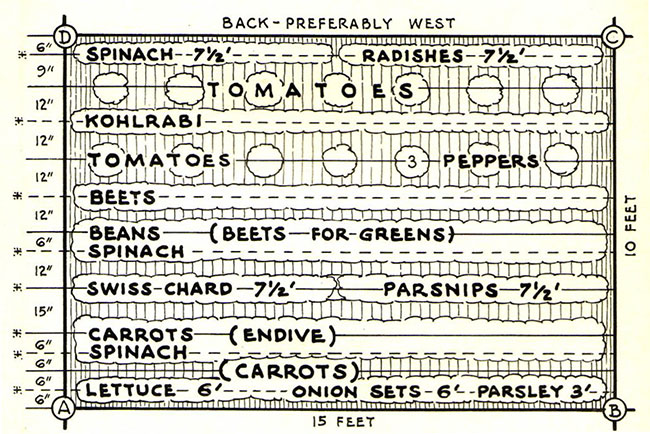
A Medium-Sized Victory Garden for 2 to 4 Persons
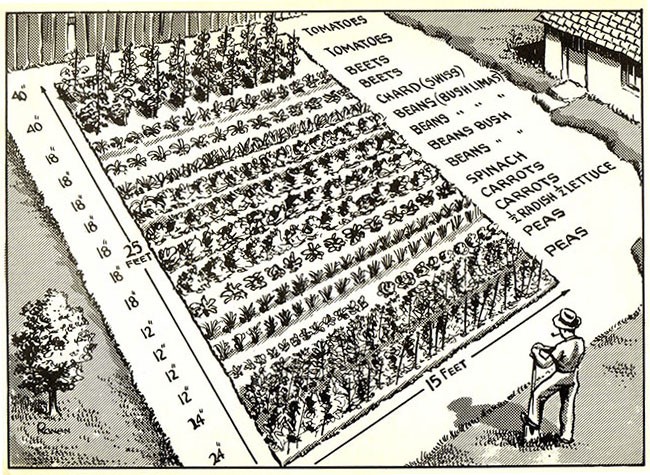
A Large-Sized Victory Garden for 4 to 7 Persons
This is a much larger garden than looks on paper! Measure the space off outside and see how really big it is. Do not plan this size if you are a “weekend” gardener and must do all of the work by yourself. It will take the spare time of two people. For convenience in planting, the garden has been divided into two sections. Most of the late maturing crops are in the second section.
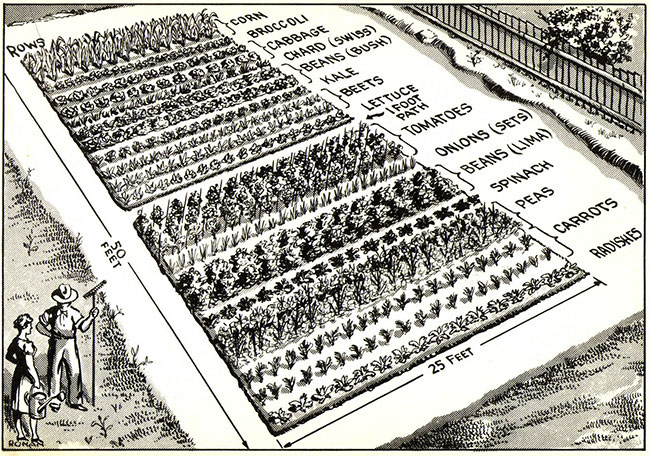
Now that you have your victory garden site planned out. The next step is preparing the soil for that garden.
The ABC of Victory Gardens Pamphlet
Much of this post came from the ABC of Victory Gardens pamphlet distributed widely during World War II. We have made the complete pamphlet available for download in PDF format. Click here to get a copy.
Further Recommendations
If you’re new to gardening, consider a copy of Mel Bartholomew’s best-selling book All New Square Foot Gardening. Then, when you’ve inevitably produced way more vegetables than you can eat in a season (a common beginner’s mistake), you’ll want a copy of the USDA’s Complete Guide to Home Canning.
It’s the go-to source on canning, and it’s inexpensive. You can get a pressure/canner cooker to accompany canning supplies and Mason jars that run from the high-end All American 930 to the more reasonably-priced Presto 8-Quart cooker.

2 comments
We have had gardens before but this is a neighborhood garden and looking for ideas and tips.
Easy to Preserve from University of GA is a great canning and preserving resource. The ordering process is a pain but well worth it. By far the best book I have found!